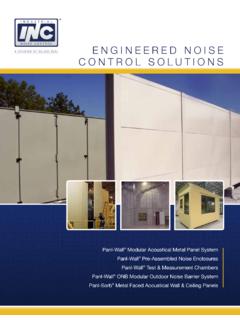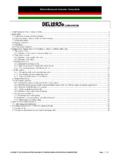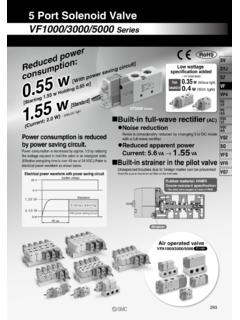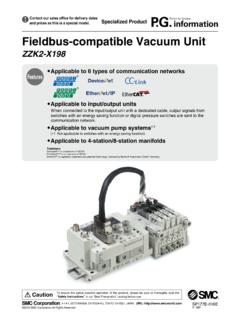Transcription of Silencer Selection Guide - Industrial Noise Control
1 INC PanlINC Panl--FlowFlow HVAC and Industrial SilencersHVAC and Industrial silencers Selection GuideSelection Guide 401 Airport Road North Aurora, IL 60542 800-954-1998 INC Bulletin # 008-1001 Panl-Flow silencers SELECTING THE PROPER Silencer Selecting the proper Panl-Flow Silencer will ensure adequate and economical sound attenuation for your application. The first step is to analyze your system and determine the amount of Noise reduc-tion required. This is expressed as insertion loss in decibels when referring to Silencer acoustical performance data. You will also need to know the maximum amount of resistance you can add to the air flow that your system can handle. This is expressed as static pressure drop in inches of water (WG) and is the additional resistance the fan or air moving equipment in the system will have to be able to overcome to maintain the same air flow and efficiency.
2 You should have the following information available when making your Silencer Selection : Insertion Loss in dB required at each octave band frequency from 63 hz to 8000 hz Total air flow in CFM Maximum static pressure drop in inches per water column (WG) Duct, exhaust or fan size dimensions Maximum allowable length of Silencer Once you have this information you will be able to simply select the Silencer size and model that matches your criteria. You will see that we have two basic Silencer designs, one resulting in Stan-dard Pressure Drops (our Model SP) and one resulting in Lower Pressure Drops (our Model LP). Typically low pressure drop silencers result in lower insertion loss as well, especially in the lower frequency ranges. Straight through airflow passages Perorated absorptive Interior baffles Typical Cross-Section of Panl-Flow Absorptive Silencer How An Absorptive Silencer Works INC Panl-Flow absorptive Silencer works by directing the airflow containing the un-wanted Noise through a series of highly sound absorptive passages of various lengths and widths causing the sound energy to de dissipated by the sound absorb-ing media while allowing the air to flow relatively unimpeded.
3 The length and ratio of width to height relative to the frequency of the sound determines the amount of sound attenuation or insertion loss that the Silencer will provide. Generally, the longer the Silencer the greater the attenuation, especially at the lower frequency ranges. Because the interior surfaces of the airflow passages are perforated metal and of a smaller free area than the originating ductwork, friction is encountered that results in increased resistance that the air flow must overcome. This is known as static pres-sure. Panl-Flow Airflow Charts Model SP Panl-Flow Airflow Charts Model LP Panl-Flow Acoustical Perfomance The air flowing through a Silencer generates a certain amount of Noise by doing so. The following chart shows the values of this self-generated Noise that should be considered in your system. The resulting total sound level that you are expecting after installing a Silencer in the system cannot be lower than the self-generated sound level.
4 Panl-Flow Silencer Construction 401 Airport Road North Aurora, IL 60542 800-954-1998 Silencer Design & Construction INC Panl-Flow silencers are of an absorptive design, manufactured in square and rectangular sizes with round transitions to match common ductwork and equipment dimensions. Our silencers are constructed of an exterior sealed shell with sound absorbing baffles or bullets running lengthwise through the si-lencer. Panl-Flow construction features: Rigid assembly with all exterior joints and seams lock-formed to be air and water-tight. Standard 26 gauge solid exterior with 22 gauge interior perforated interior bullets designed and sized for maximum performance. Heavy 18 gauge exterior casings available for low break-out Noise . Solid rounded aerodynamic bullet ends for minimum pressure drop and smooth air flow. Absorptive fill is inert, and meets ASTM E-84 Class I fire rating.
5 Custom designs available for a wide range of CFM, pressure drop and insertion loss requirements. Standard materials include G90 galvanized, electro-galvanized, aluminum and stainless steel. Accessories & Options silencers can stacked in banks for large openings applications. All silencers can be fitted with mounting flanges, bird screens, and weather caps. Compatible elbows and other ducting transition shapes available. Cross-talk designs available. Industrial Noise Control , Inc. All rights reserved.










